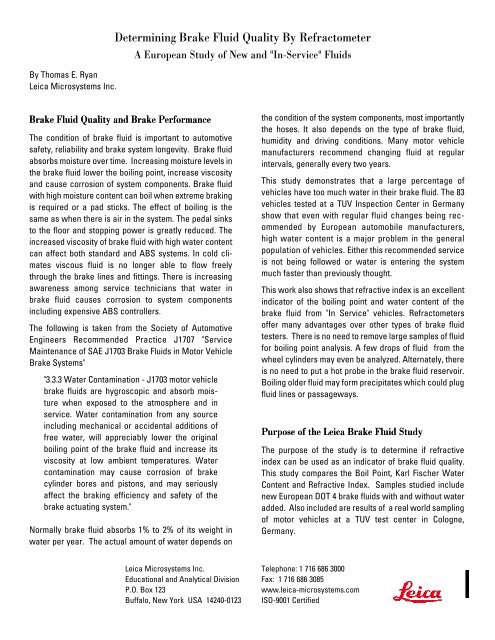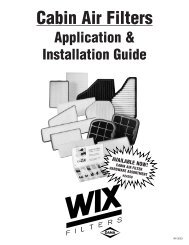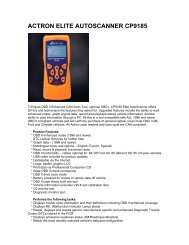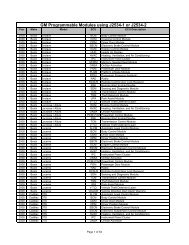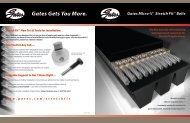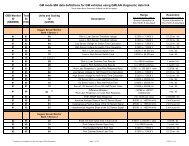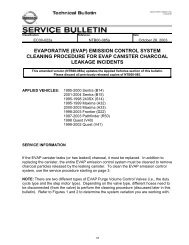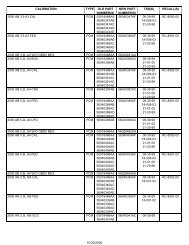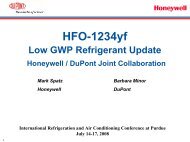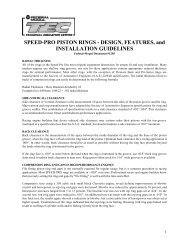Determining Brake Fluid Quality By Refractometer - AA1Car
Determining Brake Fluid Quality By Refractometer - AA1Car
Determining Brake Fluid Quality By Refractometer - AA1Car
Create successful ePaper yourself
Turn your PDF publications into a flip-book with our unique Google optimized e-Paper software.
<strong>By</strong> Thomas E. Ryan<br />
Leica Microsystems Inc.<br />
<strong>Determining</strong> <strong>Brake</strong> <strong>Fluid</strong> <strong>Quality</strong> <strong>By</strong> <strong>Refractometer</strong><br />
<strong>Brake</strong> <strong>Fluid</strong> <strong>Quality</strong> and <strong>Brake</strong> Performance<br />
The condition of brake fluid is important to automotive<br />
safety, reliability and brake system longevity. <strong>Brake</strong> fluid<br />
absorbs moisture over time. Increasing moisture levels in<br />
the brake fluid lower the boiling point, increase viscosity<br />
and cause corrosion of system components. <strong>Brake</strong> fluid<br />
with high moisture content can boil when extreme braking<br />
is required or a pad sticks. The effect of boiling is the<br />
same as when there is air in the system. The pedal sinks<br />
to the floor and stopping power is greatly reduced. The<br />
increased viscosity of brake fluid with high water content<br />
can affect both standard and ABS systems. In cold climates<br />
viscous fluid is no longer able to flow freely<br />
through the brake lines and fittings. There is increasing<br />
awareness among service technicians that water in<br />
brake fluid causes corrosion to system components<br />
including expensive ABS controllers.<br />
The following is taken from the Society of Automotive<br />
Engineers Recommended Practice J1707 "Service<br />
Maintenance of SAE J1703 <strong>Brake</strong> <strong>Fluid</strong>s in Motor Vehicle<br />
<strong>Brake</strong> Systems"<br />
"3.3.3 Water Contamination - J1703 motor vehicle<br />
brake fluids are hygroscopic and absorb moisture<br />
when exposed to the atmosphere and in<br />
service. Water contamination from any source<br />
including mechanical or accidental additions of<br />
free water, will appreciably lower the original<br />
boiling point of the brake fluid and increase its<br />
viscosity at low ambient temperatures. Water<br />
contamination may cause corrosion of brake<br />
cylinder bores and pistons, and may seriously<br />
affect the braking efficiency and safety of the<br />
brake actuating system."<br />
Normally brake fluid absorbs 1% to 2% of its weight in<br />
water per year. The actual amount of water depends on<br />
A European Study of New and "In-Service" <strong>Fluid</strong>s<br />
Leica Microsystems Inc.<br />
Educational and Analytical Division<br />
P.O. Box 123<br />
Buffalo, New York USA 14240-0123<br />
the condition of the system components, most importantly<br />
the hoses. It also depends on the type of brake fluid,<br />
humidity and driving conditions. Many motor vehicle<br />
manufacturers recommend changing fluid at regular<br />
intervals, generally every two years.<br />
This study demonstrates that a large percentage of<br />
vehicles have too much water in their brake fluid. The 83<br />
vehicles tested at a TUV Inspection Center in Germany<br />
show that even with regular fluid changes being recommended<br />
by European automobile manufacturers,<br />
high water content is a major problem in the general<br />
population of vehicles. Either this recommended service<br />
is not being followed or water is entering the system<br />
much faster than previously thought.<br />
This work also shows that refractive index is an excellent<br />
indicator of the boiling point and water content of the<br />
brake fluid from "In Service" vehicles. <strong>Refractometer</strong>s<br />
offer many advantages over other types of brake fluid<br />
testers. There is no need to remove large samples of fluid<br />
for boiling point analysis. A few drops of fluid from the<br />
wheel cylinders may even be analyzed. Alternately, there<br />
is no need to put a hot probe in the brake fluid reservoir.<br />
Boiling older fluid may form precipitates which could plug<br />
fluid lines or passageways.<br />
Purpose of the Leica <strong>Brake</strong> <strong>Fluid</strong> Study<br />
The purpose of the study is to determine if refractive<br />
index can be used as an indicator of brake fluid quality.<br />
This study compares the Boil Point, Karl Fischer Water<br />
Content and Refractive Index. Samples studied include<br />
new European DOT 4 brake fluids with and without water<br />
added. Also included are results of a real world sampling<br />
of motor vehicles at a TUV test center in Cologne,<br />
Germany.<br />
Telephone: 1 716 686 3000<br />
Fax: 1 716 686 3085<br />
www.leica-microsystems.com<br />
ISO-9001 Certified
Leica uses the definitions of brake fluids described by<br />
The Society of Automotive Engineers (SAE). To be a valid<br />
<strong>Brake</strong> <strong>Fluid</strong> it must meet the requirements of SAE<br />
Standard 1704 (DOT 4 Type <strong>Brake</strong> <strong>Fluid</strong>s). The wet and dry<br />
DOT 4 boil points specified in the standard are:<br />
Dry Boil Point: 230oC Standard, 260oC Super<br />
Wet Boil Point: 155oC Standard, 180oC Super<br />
(approx 3.7% Water)<br />
There is no industry consensus on what constitutes good<br />
versus bad fluid. The wet boil point is generally accepted<br />
as a cutoff point for changing fluid. TUV has stated that<br />
the cutoff should be 180 o C because fluid in the reservoir<br />
generally has less absorbed water and a higher boil point<br />
than fluid in the wheel cylinders. The wheel cylinders are<br />
located closer to the flexible rubber hoses where most of<br />
the water ingression is believed to take place.<br />
The accuracy with which boil point and water content<br />
can be measured is open to discussion. This includes<br />
results obtained using SAE approved methods. Even with<br />
these methods a great deal of variability is seen. The<br />
Society of Automotive Engineers <strong>Brake</strong> <strong>Fluid</strong> Committee<br />
is actively discussing variation in results during wet and<br />
dry boil point testing. Typical results of round robin tests<br />
at well-known laboratories with experience in testing<br />
brake fluid are shown in the attached Figure 1 a & b.<br />
Figure 1 shows a recent ASTM laboratory boil point test<br />
on Dow HD 50 brake fluid conducted by SAE at six different<br />
laboratories associated with companies that make<br />
brake fluid. The results ranged from 280 o C to 297 o C. 17<br />
Degrees Centigrade variation on a single test fluid<br />
when tested by experienced chemists using an<br />
approved laboratory method and apparatus. Similarly<br />
with Karl Fisher, SAE test results on the same sample at<br />
six different laboratories ranged from 2.44 to 3.93. <strong>By</strong> its<br />
nature brake fluid is not an easy substance to measure.<br />
Normal data spread in chemical analysis is caused by<br />
contamination, operator error, poor storage, loss of<br />
calibration, insufficient cooling of the boil type tester,<br />
coated electrodes on the Karl Fischer titrator, etc. A list<br />
obtained from SAE of probable causes for variation in boil<br />
point testing is attached as Figure 2. Some variability in<br />
brake fluid analysis data is expected. In the final analysis,<br />
the work described here shows this variability does not<br />
Leica Microsystems Inc.<br />
Educational and Analytical Division<br />
P.O. Box 123<br />
Buffalo, New York USA 14240-0123<br />
interfere with the ability of any of the methods used in this<br />
study (Karl Fischer, ASTM Boil Point, Refractive Index) to<br />
determine good from bad brake fluid.<br />
Results: Boil Point, Karl Fischer % Water, and<br />
Refractive Index<br />
The chart in Figure 3 a shows the relationship between %<br />
Water and Boil point for 18 new European origin brake<br />
fluids with water added. These fluids represent all the<br />
Boil Point, Deg. Centigrade<br />
300<br />
280<br />
260<br />
240<br />
220<br />
200<br />
180<br />
160<br />
140<br />
DOT 4 fluids specified by European automobile manufacturers<br />
and importers. They were sourced from retail<br />
automobile sales outlet and service centers, brake fluid<br />
manufacturers and automotive supply stores. Figure 3<br />
compares the two SAE and ISO accepted and specified<br />
methods - Karl Fischer Titration and Boil Point readings.<br />
Both methods are described and approved as ASTM<br />
official methods. The results show typical expected<br />
variability. Two of the DOT 4 fluids we purchased and<br />
tested did not meet the minimum dry boil point specification<br />
for DOT 4 fluids. These were not OEM supplied or<br />
specified fluids. The two fluids not meeting the specifi-<br />
Telephone: 1 716 686 3000<br />
Fax: 1 716 686 3085<br />
www.leica-microsystems.com<br />
ISO-9001 Certified<br />
Figure 3. Euro DOT 4 New <strong>Fluid</strong>s<br />
With Water Added<br />
120<br />
0.0 1.0 2.0 3.0 4.0 5.0 6.0 7.0 8.0<br />
% Water, wt./wt.
cation are not included in the results. The majority of the<br />
brake fluids exceed the minimum specs by a large<br />
amount. In fact we found most new DOT 4 boils at the<br />
260 o C Super Specification.<br />
Figure 4 compares Refractive Index to % Water as determined<br />
by Karl Fischer Titration. The trend is decreasing<br />
refractive index with increasing water content.<br />
Refractive Index<br />
1.4470<br />
1.4460<br />
1.4450<br />
1.4440<br />
1.4430<br />
1.4420<br />
1.4410<br />
Figure 4. Euro DOT 4 <strong>Brake</strong> <strong>Fluid</strong>s<br />
New <strong>Fluid</strong>s with Water Added<br />
Quadrant I<br />
<strong>Refractometer</strong> - OK<br />
Karl Fischer - OK<br />
Quadrant III<br />
<strong>Refractometer</strong> - Change<br />
Karl Fischer OK<br />
1.4400<br />
0.0 1.0 2.0 3.0 4.0 5.0 6.0 7.0 8.0<br />
% Water, wt./wt.<br />
Quadrant II<br />
<strong>Refractometer</strong> OK<br />
Karl Fischer - Change<br />
Quadrant IV<br />
<strong>Refractometer</strong> - Change<br />
Karl Fischer - Change<br />
Figure 5 compares Refractive Index to Boil Point as determined<br />
by the SAE/ASTM specified methods. The trend is<br />
decreasing index with decreasing boil point. The variability<br />
seen in Figures 3, 4, and 5 comes from the experimental<br />
procedure errors described above plus variability<br />
in the various brake fluid formulations. Of the three methods<br />
- Karl Fischer, Boil Point and Refractive Index - the<br />
refractive index is least likely to contribute to variation<br />
due to experimental error. It is by far the least complicated<br />
method, requiring only that a sample be placed on<br />
the refractometer and read. Boil Point Determinations<br />
and Karl Fischer Titrations are much more complicated<br />
methods with more room for experimental error.<br />
Leica Microsystems Inc.<br />
Educational and Analytical Division<br />
P.O. Box 123<br />
Buffalo, New York USA 14240-0123<br />
Refractive Index<br />
1.4470<br />
1.4460<br />
1.4450<br />
1.4440<br />
1.4430<br />
1.4420<br />
1.4410<br />
Figure 5. Euro DOT 4 <strong>Brake</strong> <strong>Fluid</strong>s<br />
New <strong>Fluid</strong>s with Water Added<br />
1.4400<br />
120 140 160 180 200 220 240 260 280 300<br />
Boil Point, Deg. Centigrade<br />
Figure 6 is a histogram showing the amount of water as<br />
determined by Karl Fischer titration in the 83 automobile<br />
sample taken at the Koln, Germany test center. Obviously<br />
many cars in the sample had a great deal too much water<br />
in the <strong>Brake</strong> <strong>Fluid</strong>. The water content in 53 of the 83 cars<br />
was over 4% by weight. Figures 7 a,b,c shows the results<br />
of brake fluid testing conducted by Leica at the TUV<br />
Vehicle Test Center in Koln Germany. Figure 7a is a comparison<br />
graph of the two SAE, ISO and DOT approved<br />
methods - ASTM Boil Point Determination and Karl<br />
Frequency<br />
25<br />
20<br />
15<br />
10<br />
5<br />
0<br />
Figure 6. Koln <strong>Brake</strong> <strong>Fluid</strong> Test, N = 83<br />
1 2 3 4 5 6 7 8 9 10<br />
Telephone: 1 716 686 3000<br />
Fax: 1 716 686 3085<br />
www.leica-microsystems.com<br />
ISO-9001 Certified<br />
% Water, Value = Max in Range
Fischer Titration. The lines drawn on the graph represent<br />
the cutoff for changing fluid -- 180 o C (according to the<br />
TUV center). TUV recommends changing at 180 o C<br />
because the sample is normally taken from the master<br />
cylinder. They believe 180 o C in the master cylinder is<br />
equivalent to 155 o C at the wheel cylinders. On very few of<br />
the 83 cars did the two methods disagree about whether<br />
or not to change fluid. If you analyze each sample individually<br />
the differences can at times appear quite large.<br />
As discussed previously, certain errors are inherent in<br />
chemical analysis methods. We can also tell by reviewing<br />
boil point versus water content that very few of the 83<br />
cars actually contained Super DOT 4 fluid.<br />
Figure 7b (Refractive Index versus Karl Fischer) shows a<br />
comparison of refractive index of the fluid from the<br />
sampled vehicles compared to the Karl Fisher Titration<br />
results. The obvious trend is a decreasing index as the<br />
water content increases. This chart shows the refractive<br />
index is a good indicator of the % water content of a<br />
random sample of European automobiles. Figure 7c<br />
compares refractive index to boil point as determined by<br />
the prescribed SAE, ISO and ASTM standards. The trend<br />
is decreasing index with decreasing boil point. This chart<br />
shows there is very good correlation between the index<br />
and boil point. Both figures 7b and 7c show excellent<br />
agreement in the determining "good" fluid from "bad". The<br />
data shown is also consistent with similar data obtained<br />
for new fluids. No adjustments were made for any cars<br />
containing Super DOT 4 <strong>Fluid</strong>. Everything in this study is<br />
modeled on the Standard DOT 4 Scale. We are very confident<br />
in the refractive index readings. Samples were<br />
tested on two different <strong>Brake</strong>-Chek ® hand held brake<br />
fluid refractometers and a laboratory refractometer.<br />
Excellent correlation was observed between the handheld<br />
refractometer and the laboratory refractometer.<br />
Calibration of the laboratory refractometer was verified<br />
by reading a certified standard every 0.5 hour.<br />
Leica Microsystems Inc.<br />
Educational and Analytical Division<br />
P.O. Box 123<br />
Buffalo, New York USA 14240-0123<br />
Boil Point<br />
Index<br />
Index<br />
300<br />
280<br />
260<br />
240<br />
220<br />
200<br />
180<br />
160<br />
140<br />
120<br />
Quadrant I<br />
Both methods say change <strong>Fluid</strong><br />
Quadrant III<br />
Boil Point says change<br />
Karl Fischer Says OK<br />
Figure 7a. TUV Real World <strong>Brake</strong> <strong>Fluid</strong> Test<br />
Boil Point Compared to Karl Fischer % Water<br />
100<br />
0 1 2 3 4 5 6 7 8 9 10<br />
1.4480<br />
1.4470<br />
1.4460<br />
1.4450<br />
1.4440<br />
1.4430<br />
1.4420<br />
1.4410<br />
Telephone: 1 716 686 3000<br />
Fax: 1 716 686 3085<br />
www.leica-microsystems.com<br />
ISO-9001 Certified<br />
Quadrant II<br />
Boil Point says OK<br />
Karl Fischer says Change<br />
% Water<br />
Quadrant IV<br />
Both methods say change fluid<br />
Figure 7b. TUV Real World <strong>Brake</strong> <strong>Fluid</strong> Test<br />
Refractive Index Compared to Karl Fischer % Water<br />
Quadrant I both method say<br />
brake fluid OK<br />
Quadrant III<br />
Karl Fischer - OK<br />
<strong>Refractometer</strong> - change<br />
Quadrant II<br />
Karl Fischer - change<br />
<strong>Refractometer</strong> - ok<br />
Quadrant IV<br />
Both methods say<br />
change brake fluid<br />
1.4400<br />
0 1 2 3 4 5 6 7 8 9 10<br />
1.448<br />
1.447<br />
1.446<br />
1.445<br />
1.444<br />
1.443<br />
1.442<br />
1.441<br />
Quadrant III<br />
Both Methods<br />
change <strong>Brake</strong><br />
<strong>Fluid</strong><br />
% Water<br />
Figure 7c. TUV Real World <strong>Brake</strong> <strong>Fluid</strong> Test<br />
Refractive Index Compared to Boil Point<br />
Quadrant I<br />
<strong>Refractometer</strong> OK<br />
Boil Point Tester Change<br />
<strong>Brake</strong> Chek Scale<br />
1.44<br />
100 120 140 160 180 200 220 240 260 280<br />
Boil Point<br />
Quadrant II<br />
Both Methods <strong>Brake</strong> <strong>Fluid</strong> OK<br />
Quadrant iV<br />
Boil Point Tester OK<br />
<strong>Refractometer</strong> Change
Conclusion<br />
Refractive index is a unique physical property of chemical<br />
compounds. It is often specified as an indicator of purity<br />
and is used to determine concentration for a wide range<br />
of commercial solutions. Measuring refractive index to a<br />
high degree of accuracy (+/- 0.00002) is fairly easy and<br />
can be easily done with inexpensive handheld devices.<br />
Based on a comparison of methods between Karl Fischer<br />
titration and temperature corrected refractive index<br />
measurements this work has demonstrated that refractive<br />
index can be used to determine water concentration<br />
in European DOT 4 brake fluids.<br />
To be useful as a field test, the results from brake fluid<br />
which has been in service for a period of time must be<br />
similar to results obtained on new, clean fluid. In-service<br />
fluid is typically darker and may contain particulate contamination.<br />
The data from used fluid samples is very<br />
similar to the data for the clean, new fluids to which<br />
water was added. Contaminants in the used fluid samples<br />
appear to have little effect on the Karl Fischer titration or<br />
the refractive index measurement. The percent water<br />
versus refractive index curve fit for new and used fluids<br />
are almost identical.<br />
The safety of a motor vehicle’s braking system is directly<br />
related to the water content of the brake fluid. As water<br />
content increases, the boiling point decreases. Water<br />
content in brake fluid increases 1% to 2% per year. A<br />
recent study has shown that temperatures of brake fluid<br />
in the wheel cylinders of vehicles can reach high enough<br />
levels to boil brake fluid containing significant amounts of<br />
water. Our study on used brake fluid confirms over 60%<br />
of the vehicles tested in Germany had brake fluid with<br />
water content above 4%. On the average 4% water<br />
reduces the boiling point by 100 degrees centigrade. The<br />
brake fluid in the vehicles which tested over 4% water<br />
could reach the boiling point under high braking load for<br />
short periods or light but continuous braking such as<br />
encountered when descending from elevation.<br />
If 4% water as measured by Karl Fischer titration was<br />
chosen as a cutoff point for our used vehicle sample the<br />
data relating refractive index to % water content shown<br />
in Figure 7b would have correctly predicted and agreed<br />
on fluid quality in 74 of the 83 vehicles. All of the vehicles<br />
Leica Microsystems Inc.<br />
Educational and Analytical Division<br />
P.O. Box 123<br />
Buffalo, New York USA 14240-0123<br />
in quadrant three of Figure 7b had at least 3% water content.<br />
In quadrant 3 the Karl Fisher % water indicates the<br />
fluid does not need to be changed but the refractive index<br />
does. Figure 7b shows that at most the error in the %<br />
water measurement will be 1%. The refractive index versus<br />
boil point chart (Figure 7c) shows similar results. The<br />
boil tester and refractive index agreed in 75 of the 83 cars<br />
tested. The degree of accuracy in predicting whether or<br />
not a car requires a fluid change is the same as when the<br />
two standard methods, Karl Fischer Titration and Boil<br />
Point determination are compared (see Figure 7a).<br />
Regular checking of brake fluid by measuring the refractive<br />
index with a tool such as the Leica <strong>Brake</strong> Chek could<br />
eliminate a safety hazard represented by vehicles with<br />
high moisture content It could also help extend the life of<br />
brake system components and reduce maintenance by<br />
minimizing corrosion due to high water content. It should<br />
also be kept in mind that this study covered the entire<br />
population of brake fluids. No corrections were made for<br />
DOT 4 versus Super DOT 4 or even DOT 3. The accuracy<br />
with which boiling point and % water measurements are<br />
estimated by refractometer can be greatly increased by<br />
calibrating the Leica <strong>Brake</strong> Chek to the recommended<br />
OEM brake fluid and then checking at regular service<br />
intervals at the Dealer. This is the best possible way of<br />
assuring safe brake fluid and follows the Society of<br />
Automotive Engineers recommendation in Recommended<br />
Practice J1707:<br />
"Whenever the vehicle manufacturer clearly<br />
specifies of otherwise indicates the brake fluid<br />
required, service maintenance personnel should<br />
use the brake fluid recommended by the vehicle<br />
manufacturer"<br />
We believe checking brake fluid is even more important<br />
in vehicles with "super" fluids formulated to maintain a<br />
high boiling point at high water contents. While the boil<br />
point of this type of fluid may be in the safe range, there<br />
is still a likelihood of corrosion damage or brake system<br />
malfunction due to the increase in viscosity caused by<br />
high water content.<br />
Telephone: 1 716 686 3000<br />
Fax: 1 716 686 3085<br />
www.leica-microsystems.com<br />
ISO-9001 Certified
Figure 1a<br />
Round Robin Boiling Point, F ( Dow Chemical HD50 – 4 <strong>Brake</strong> <strong>Fluid</strong> )<br />
Procedure Dow<br />
Chemical<br />
Orthene<br />
Chemical<br />
Leica Microsystems Inc.<br />
Educational and Analytical Division<br />
P.O. Box 123<br />
Buffalo, New York USA 14240-0123<br />
ABIC Labs Case<br />
Labs Castrol<br />
Standard SAE Method Run # 1 555, 553 552, 555 560, 558 565, 565, 561, 561 547, 550<br />
554, 560 550, 552 562, 562 565, 565 561, 561 550, 552<br />
Average 555 552 561 565 561 550<br />
Run # 2 552, 555 559, 556 564, 564 555, 555 556, 556 556, 554<br />
557, 554 556, 559 563, 562 555, 555 556, 556 552, 552<br />
Average 555 558 563 555 556 553<br />
Run # 3 559, 560 554, 549 562. 564 559, 559 554, 554 556, 556<br />
562, 557 545, 545 564, 563 559, 559 554, 554 558, 556<br />
Average 560 548 563 559 554 557<br />
Final Average 557 553 562 560 557 553<br />
Proposed SAE Method Run # 1 564, 563 553, 550 564, 565 568, 568 564, 564 556, 558 558, 556<br />
562, 565 550, 550 563, 560 568, 568 564, 564 558, 556 556, 556<br />
Average 564 551 563 568 564 557 557<br />
Run # 2 560, 560 556, 556 566, 565 540, 540 536, 536 558, 558 558, 558<br />
563, 562 556, 556 564, 564 540, 540 536, 536 558, 554<br />
Average 561 556 565 540 536 557 558<br />
Run # 3 562, 564 547, 550 562, 562<br />
558, 558 558, 560<br />
561, 560 554, 554 560, 562<br />
554, 554 558, 556<br />
Average 562 551 562 556 558<br />
Final Average 562 553 563 554 550 557 558<br />
Telephone: 1 716 686 3000<br />
Fax: 1 716 686 3085<br />
www.leica-microsystems.com<br />
ISO-9001 Certified
3 Days<br />
Leica Microsystems Inc.<br />
Educational and Analytical Division<br />
P.O. Box 123<br />
Buffalo, New York USA 14240-0123<br />
Figure 1B<br />
Exhibit II<br />
SBR Rubber Cups Swell Test At 70°C With and Without Water Added.<br />
Using RM- 66-04 <strong>Brake</strong> <strong>Fluid</strong><br />
% Volume Swell<br />
Diameter Change (inches)<br />
Hardness Change<br />
% Water Content<br />
5 Days<br />
% Volume Swell<br />
Diameter Change (inches)<br />
Hardness Change<br />
% Water Content<br />
7 Days<br />
% Volume Swell<br />
Diameter Change (inches)<br />
Hardness Change<br />
% Water Content<br />
10 Days<br />
% Volume Swell<br />
Diameter Change (inches)<br />
Hardness Change<br />
% Water Content<br />
4.77<br />
0.17<br />
-1<br />
.35<br />
3.97<br />
.014<br />
-2<br />
.35<br />
3.66<br />
.013<br />
-2<br />
.38<br />
3.35<br />
.012<br />
-3<br />
.39<br />
Testing Laboratories<br />
Case Consulting Seiken Chemical Acushnet<br />
Dry Wet Dry Wet Dry Wet<br />
2.74<br />
.011<br />
-3<br />
3.05<br />
1.86<br />
.007<br />
-3<br />
2.99<br />
1.64<br />
.006<br />
-2<br />
2.97<br />
1.46<br />
.005<br />
-3<br />
2.94<br />
4.98<br />
.020<br />
-1<br />
.34<br />
3.97<br />
.014<br />
-2<br />
.35<br />
4.28<br />
.016<br />
-6<br />
.37<br />
3.86<br />
.014<br />
-4<br />
.38<br />
2.66<br />
.012<br />
-3<br />
3.05<br />
1.86<br />
.007<br />
-3<br />
2.99<br />
1.77<br />
.008<br />
-4<br />
3.18<br />
1.40<br />
.006<br />
-3<br />
3.13<br />
5.05<br />
.015<br />
-9<br />
.54<br />
4.5<br />
.017<br />
-9<br />
.68<br />
3.9<br />
.017<br />
-9<br />
1.33<br />
3.4<br />
.012<br />
-9<br />
.52<br />
Telephone: 1 716 686 3000<br />
Fax: 1 716 686 3085<br />
www.leica-microsystems.com<br />
ISO-9001 Certified<br />
2.95<br />
.010<br />
-7<br />
2.44<br />
2.5<br />
.008<br />
-7<br />
2.34<br />
2.35<br />
.008<br />
-7<br />
2.6<br />
2.25<br />
.008<br />
-7<br />
1.6
3 Days<br />
Leica Microsystems Inc.<br />
Educational and Analytical Division<br />
P.O. Box 123<br />
Buffalo, New York USA 14240-0123<br />
Figure 1b (cont’d.) ( cont’d.)<br />
Exhibit III<br />
SBR Rubber Cups Swell Test At 70°C With and Without Water Added.<br />
Using RM- 66-04 <strong>Brake</strong> <strong>Fluid</strong><br />
% Volume Swell<br />
Diameter Change (inches)<br />
Hardness Change<br />
% Water Content<br />
5 Days<br />
% Volume Swell<br />
Diameter Change (inches)<br />
Hardness Change<br />
% Water Content<br />
7 Days<br />
% Volume Swell<br />
Diameter Change (inches)<br />
Hardness Change<br />
% Water Content<br />
10 Days<br />
% Volume Swell<br />
Diameter Change (inches)<br />
Hardness Change<br />
% Water Content<br />
5.04<br />
.019<br />
-5<br />
.35<br />
4.71<br />
.016<br />
-6<br />
.35<br />
4.32<br />
.016<br />
-6<br />
.37<br />
3.87<br />
.014<br />
-6<br />
.38<br />
Testing Laboratories<br />
Castrol Oxid Inc. Complex<br />
Dry Wet Dry Wet Dry Wet<br />
2.89<br />
.010<br />
-6<br />
3.24<br />
2.50<br />
.008<br />
-6<br />
3.26<br />
2.10<br />
.008<br />
-6<br />
3.31<br />
1.75<br />
.006<br />
-5<br />
3.30<br />
4.76<br />
.017<br />
-.4<br />
.35<br />
4.51<br />
.016<br />
-2<br />
.35<br />
3.57<br />
.015<br />
-2<br />
.35<br />
2.15<br />
.007<br />
-3<br />
3.93<br />
1.26<br />
.009<br />
-2<br />
4.13<br />
1.02<br />
.005<br />
-1<br />
3.97<br />
6.41<br />
.015<br />
7.15<br />
.015<br />
5.93<br />
.015<br />
5.55<br />
.016<br />
Telephone: 1 716 686 3000<br />
Fax: 1 716 686 3085<br />
www.leica-microsystems.com<br />
ISO-9001 Certified<br />
3.42<br />
.007<br />
3.00<br />
4.86<br />
.004<br />
4.79<br />
-.004<br />
5.10<br />
-.004
A. Humidification Procedure<br />
Figure 2<br />
Variables Effecting Wet Boiling Point Results<br />
. Dessicator dimensions ( size, volume )<br />
. Dessicator plate design ( hole size )<br />
. Oven Temperature<br />
. Placement of test jars within the dessicator<br />
. Sampling procedure<br />
. Water determination method<br />
. <strong>Quality</strong> of TEGME<br />
B. Boiling Point Variables<br />
. Size of glass ( flask, condenser )<br />
. Volume of fluid contained in the flask<br />
. Thermometer calibration<br />
. Boiling point chips ( size, number, water content etc. )<br />
. Heating method<br />
. Reflux rate<br />
. Stabilization time<br />
. Cooling water temperature<br />
. Barometric pressure correction<br />
. Glassware cleanliness ( residual brake fluid, water etc. )<br />
Leica Microsystems Inc.<br />
Educational and Analytical Division<br />
P.O. Box 123<br />
Buffalo, New York USA 14240-0123<br />
Telephone: 1 716 686 3000<br />
Fax: 1 716 686 3085<br />
www.leica-microsystems.com<br />
ISO-9001 Certified


